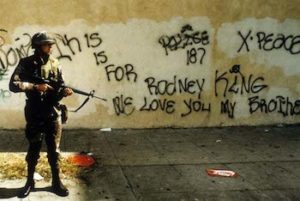
Burning in South Central
*On this date, the Los Angeles (Rodney King) Riot began in 1992. One of the first major urban insurrections in the United States after the 1960s, this riot shocked many Americans who had come to believe that the days of explosive racial tensions were behind them.
Like the Los Angeles Watts Riot of 1965, the 1992 rioting was sparked by Black citizens' police brutality. On March 3, 1991, police officers in Los Angeles, California, stopped a car driven by a 34-year-old African American named Rodney King, who, they said, was speeding. According to the officers, King emerged from his automobile aggressively, suggesting he might have been high on drugs. Before handcuffing King, the police delivered 56 blows and kicks and several shocks from a stun gun to the fallen body of the suspect.
A bystander captured the beating on videotape, and within two days, the footage was broadcast on national television. King brought charges of brutality against four of the policemen. The officers, who claimed they acted in self-defense, were tried before a predominantly white jury in a white middle-class suburb of Los Angeles. On April 29, 1992, all four men were acquitted.
Within two and a half hours of the verdict, a crowd of furious protesters gathered at the corner of Florence and Normandie Streets in South Central Los Angeles. The next day and night, rioting exploded across 50 square miles. At the same time, smaller disturbances erupted in cities such as San Francisco, California; Seattle, Washington; Atlanta, Georgia; and Pittsburgh, Pennsylvania.
President George Bush called in 4,500 United States Army troops to quell the rioting, which ended on Friday, May 1. In three days of turbulence, more than 50 people were killed, almost 400 injured, and about 17,000 arrested. The city incurred an estimated $1 billion worth of damage. Unlike the race riots of the 1960s, the 1992 uprising resulted in considerable Black-on-Black violence and looting of many Black-owned shops.
Korean shopkeepers were prime targets of the rioters' rage, as one minority community attacked another. Writing about the riot in a 1992 essay, "Learning to Talk of Race," philosopher Cornel West suggested, "what we witnessed in Los Angeles was the consequence of a lethal linkage of economic decline, cultural decay, and political lethargy in American life. Race was the visible catalyst, not the underlying cause."
In a 1992 interview with the journal Covert Action Information Bulletin, labor historian Mike Davis offered a similar opinion, calling the riot "a hybrid social revolt with three major dimensions. It was a revolutionary-democratic protest characteristic of African American history when the major institutions have thwarted demands for equal rights. It was also a major postmodern bread riot—an uprising of not just poor people but particularly of those strata of poor in southern California who've been most savagely affected by the recession [of the early 1990s]. Thirdly, it was an inter-ethnic conflict, particularly the systematic destroying and uprooting of Korean stores in the Black community."
The 1992 riot represented a rude awakening for many Americans, who had assumed that after two relatively quiet decades, the days of large-scale urban race riots were a thing of the past.